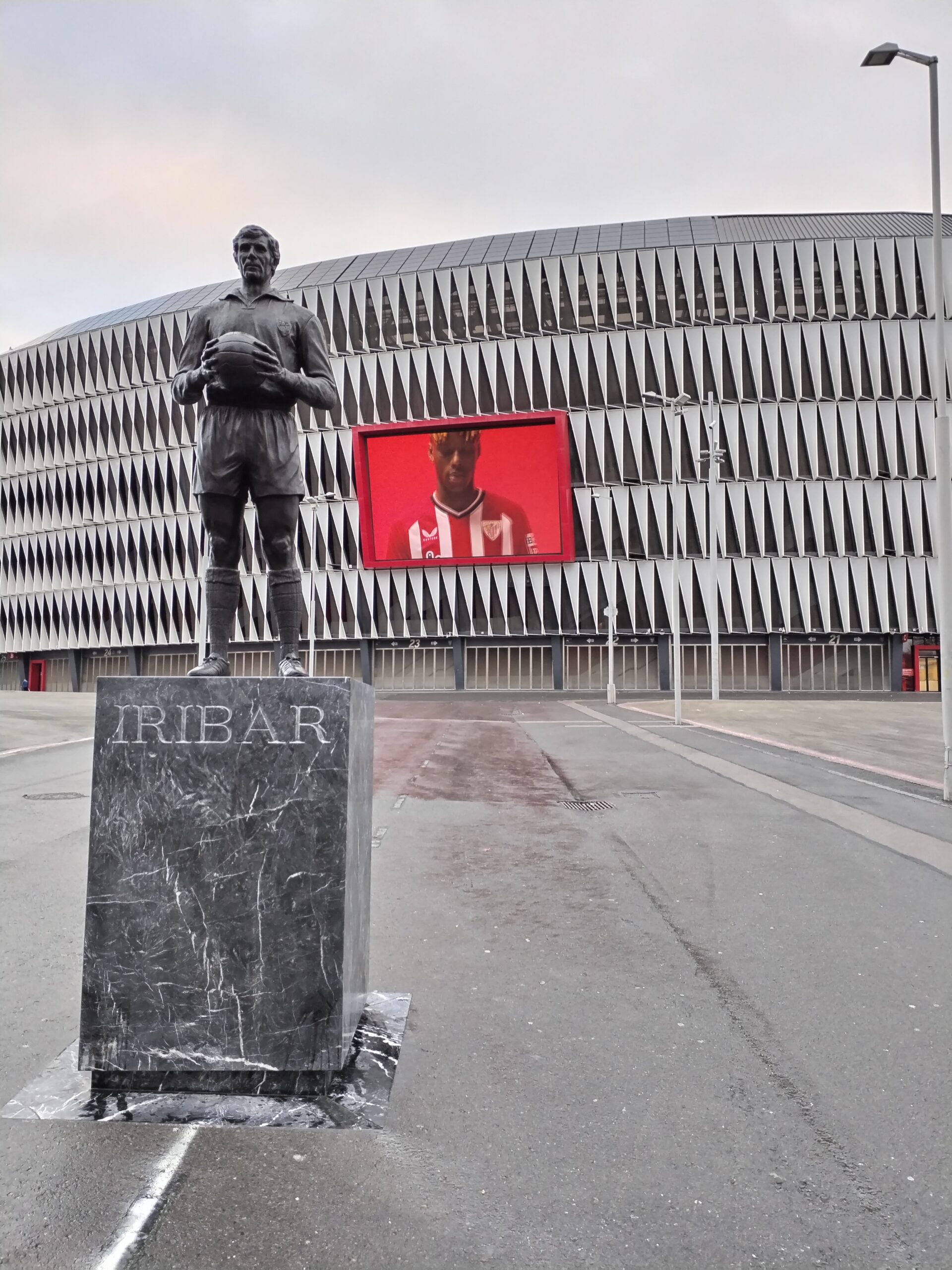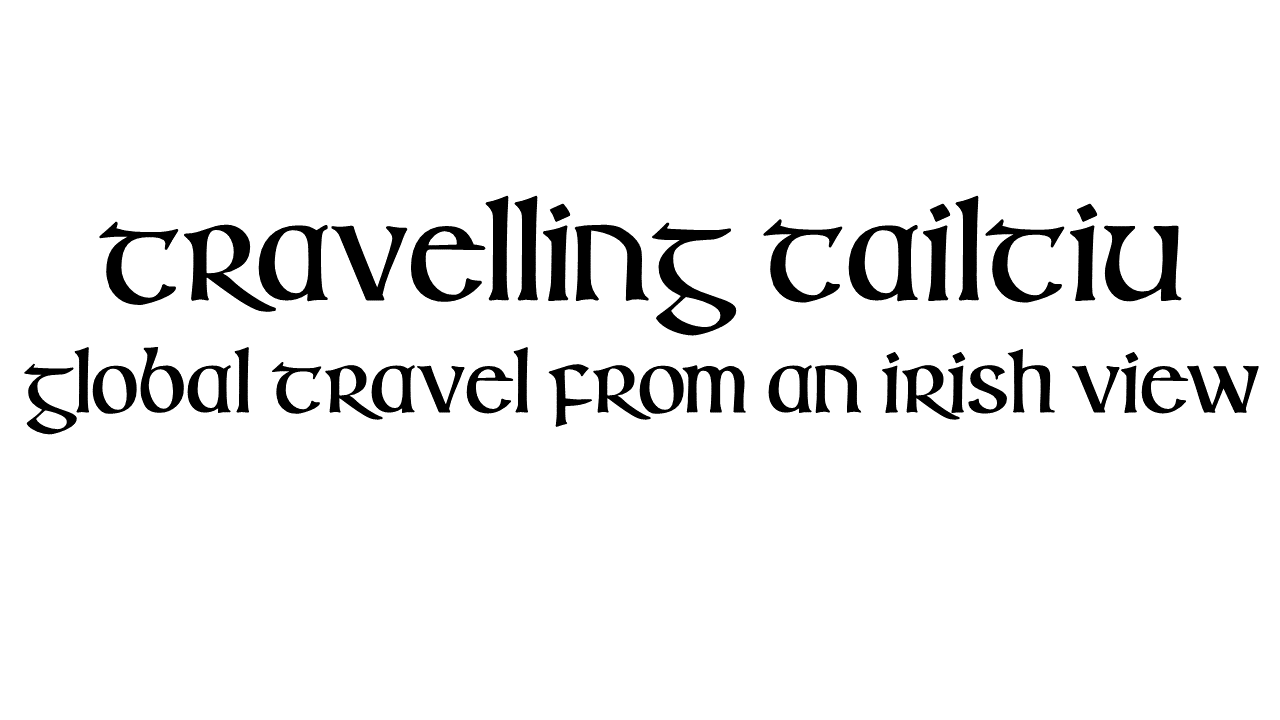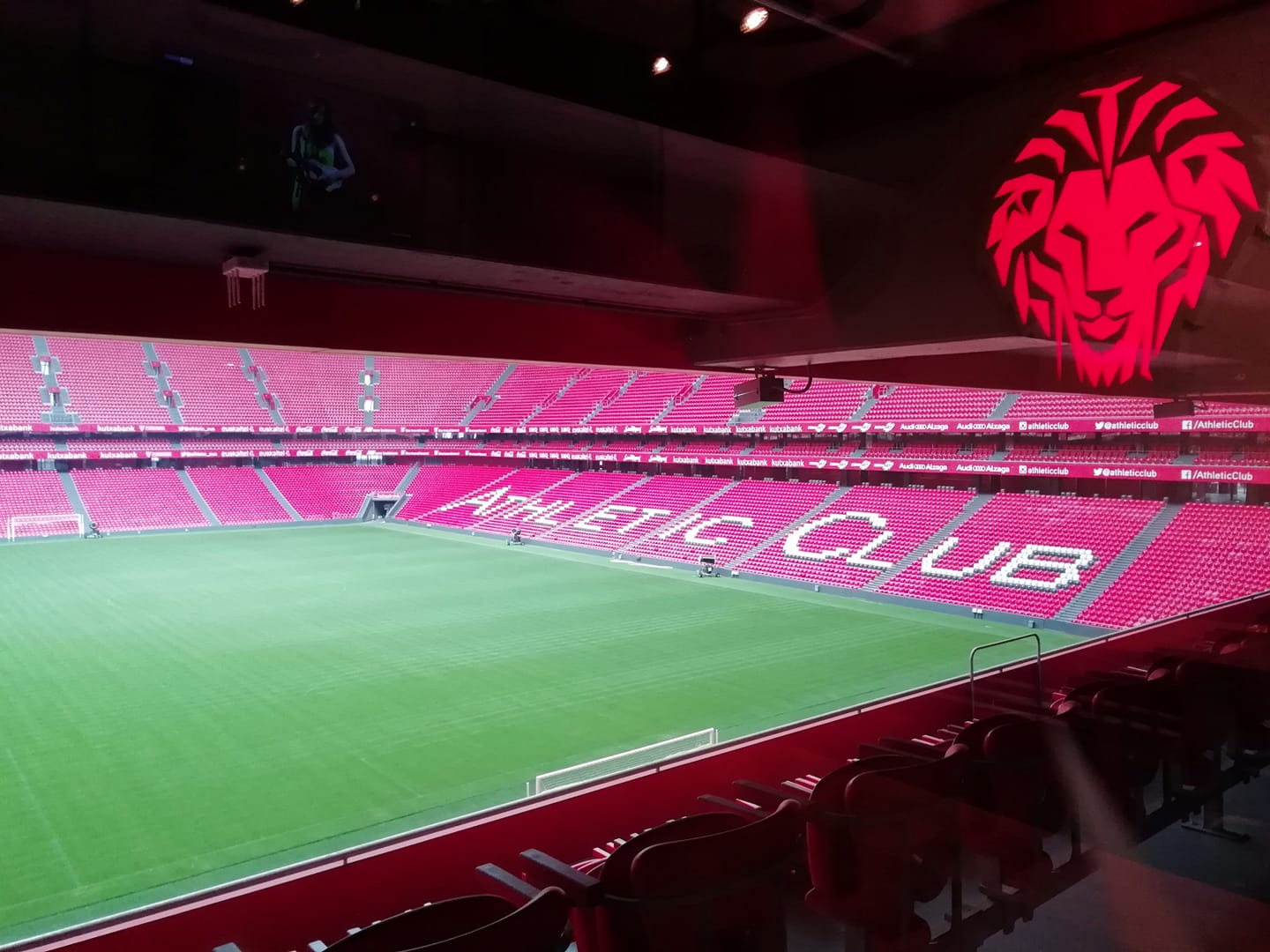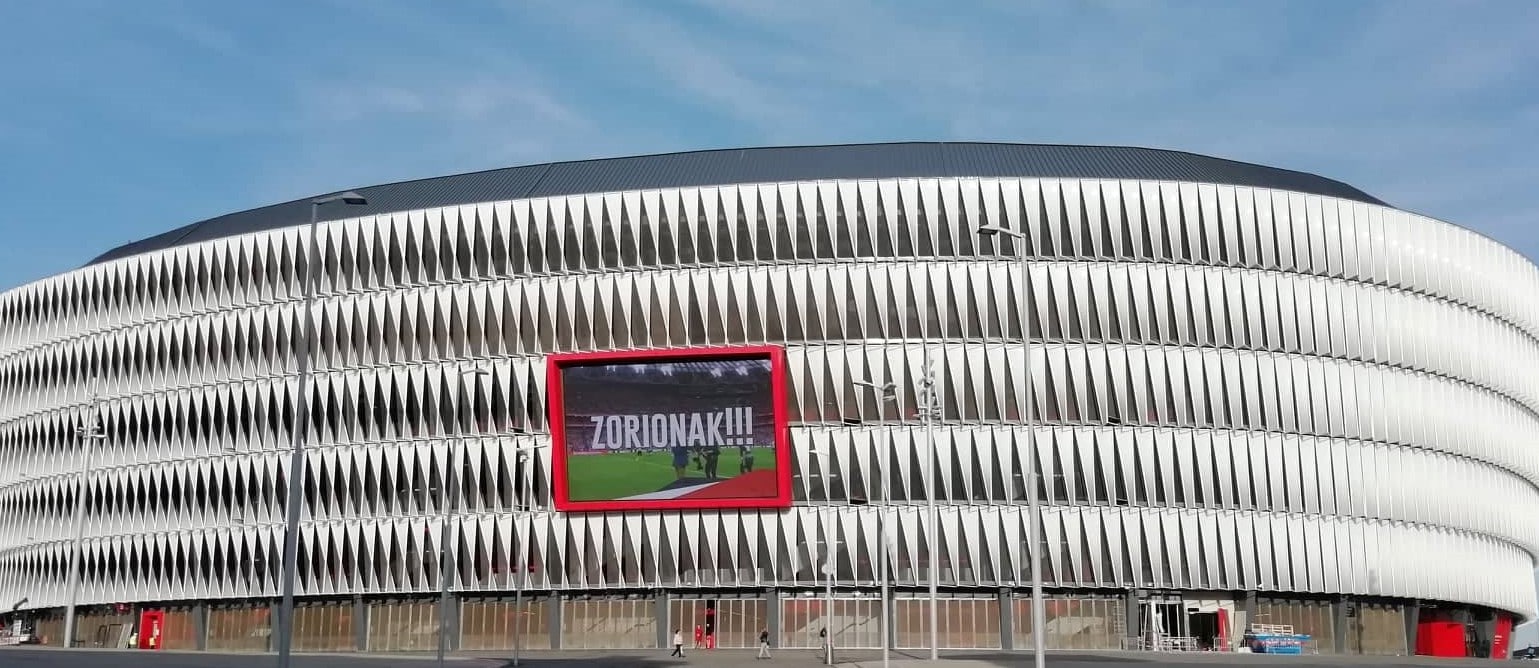All Iron and the English Compound
Athletic Bilbao and the origins of football in the Basque Country.

Old and new; statue of legendary Athletic keeper Iribar with current crack Nico Williams on the big screen
If you are into football and have the chance to read it, you should pick up Phil Ball’s book Morbo. Morbo details the history of Spanish football and La Liga from its inception. The book's title refers to the type and volume of passion or tension which grips supporters across the Iberian peninsula. Cultural and political rivalries in La Liga's fandom tend to play themselves out on the pitch and terraces, sometimes violently. The Spanish word morbo in itself conjures up unsettling feelings. To a foreigner maybe struggling a little to learn Spanish, fathoming the word's meaning might prove difficult. This struggle may well mirror their efforts to form a coherent outlook on such elements of Iberian life as they seemingly converge and play out in and around 90 competitive minutes.
The dawn of football in the Iberian Peninsula.
The first Iberian teams were Andalusian, Recreativo de Huelva dating from 1889 and Seville F.C from 1890. However, football really took an early hold in the Basque Country, with several clubs forming early in the 20th Century. Athletic Bilbao traces its formation to 1898 and consolidated itself as an entity over the subsequent years. The sport had been imported by local students returning from study in British universities, and English shipbuilders and miners. Many came from the port of Southampton and the mining centre of Sunderland, possibly explaining Athletic's red and white strip.
The Iron Hills
It was iron ore which drove the city's economic success in centuries past and further growth in the early twentieth century. This industry attracted English engineers to work in the mines in the hills of the river valley in which the city of Bilbao was growing. As Bilbao grew, it annexed several villages which are now neighbourhoods.
Along with the engineers and the English connection came the passion for football, and soon there were two local clubs. These were Bilbao Football Club and Athletic Club, which merged into Club Bizcaya in 1902. They settled on the name Athletic Club a year later, winning the first Copa del Rey. This is the equivalent of the English FA Cup, and Athletic have won it 23 times. The club names 1898 as the original date of formation though.
Free tickets for iron ore.
The story goes that mining squads who found iron ore would win free tickets to Athletic Bilbao matches. The English engineer would confirm a find by writing the words ALL IRON on the face of the rock. The miners, reading it in Spanish pronunciation as /aal-eeh-RON/, then knew that they were getting a day out at the football. It was a strong and successful team as Athletic, and the Basque Country, became a northern powerhouse in Iberian football.
La Campa de los Ingleses Bar and the seed of Basque football
Inside the stadium of Athletic Bilbao and above the official merchandise shop, on the first floor, you will find a spacious bar called La Campa de los Ingleses overlooking the pitch.
The English Compound and the birthplace of Athletic Bilbao.
Campa de los Ingleses means English Compound, and is the name of the riverside quay where the Guggenheim museum is. This was a historical point of disembarkment for English sailors. There they would rest and play football at a time when the sport was little-known to the locals. It was also the location of an English cemetary until the early 20th Century, after which the nearby area became industrialised as a shipyard. It later fell into post-industrial decline before regeneration projects spruced it up in the 1990s. Now standing in the area is the famous art museum, which looks suspiciously like a ship.
In the history of the club, the English compound is important as being the recognised birthplace of football in the city, with local interest growing in the strange game the English were playing there. La Campa de los Ingleses is now also the name of the neighbouring leafy park. This has playgrounds, bicycle lanes and iron sculptures and sits between the Guggenheim and Deusto Bridge.
Fan zones and football-friendly bars.
The bar is nice and spacious and a friendly place where you can go in wearing your own team's shirt and maybe get a conversation with the barstaff about the football while you are having a beer and a bite to eat. It is open every day of the week except matchdays. This really isn't too much of a problem as the stadium is surrounded by football-minded bars. Pozas Street leads directly away from the front of the giant TV screen at the stadium front. The screen replaced the famous old Athletic Club crest which you used to be able to see all the way down this street. Pozas is famous for the bar-laden fanzone that it becomes during match days, and can get a bit hectic.
Success, dormancy and revival in the modern era.
The heyday of Athletic Bilbao.
The most successful era of Athletic Bilbao was prior to the 1960s. They won the league and cup numerous times and on occasion as a double. The bowler-hatted Fred Pentland, an Englishman who managed the team in the 1920s and 1930s, is now an iconic image of the club and its folklore. Another famous Englishman to lead the team many years later in the 1980s was the late, great Howard Kendall. He had managed Everton through a very successful spell, though his time with Athletic Club was less so. However, his standing with the fans certainly didn't suffer. He made a return as an honoured guest of the club a year or so before he died in 2015 and his legacy in the city lives on. There is even a special local cocktail which he was fond of drinking named in his honour.
Strife.
Prior to Kendall's arrival in the 1980s, Athletic Bilbao had won their last trophies in the 1983-84 season. This was a league and cup double which culminated in an infamous pitched battle between Athletic and Barcelona staff. Many from the teams and trainers went at each other at the end of the cup final. Notoriously, this was Diego Maradona's final game with Barça, which was apparently partly because of the fight. Athletic would have to wait until 2015 to break their cup-winning duck. This time they won the Spanish Supercup, ironically but albeit in more friendly yet competitive circumstances, against Barça.
Stagnancy.
The period between the late 1980s and the second decade of the 21st Century left many fans frustrated and the local signing policy came under scrutiny. The club only considers players with origins in the seven provinces of the wider Basque Country, including Navarre and three provinces across the border with France, for selection in a pre-Bosman-esque signing policy. There is a kind of 'granny rule' in which the children of Basque parents may play despite being born elsewhere. The Venezuelan-born Fernando Amorebieta is a recent case, and he eventually played for the Venezuelan national team. The idea of Basque-ness is a cultural-geographical and linguistic idea to most local people nowadays. For example, Iñaki Williams, an Athletic star, has his family origins in west Africa. However, he was born in Bilbao and grew up in Pamplona, Navarre. His younger brother Nico is also an up-and-coming prospect with the club.
New arrivals and the regeneration of Athletic Bilbao.
The signing policy never changed but the manager did, with the arrival of Argentinian managerial maestro Marcelo Bielsa in 2011. Under Madman Bielsa, the team got to the finals of the Europa League and the Copa del Rey. They lost both yet restored the club's pride, going on to have regular European runs in subsequent seasons. When Ernesto Valverde replaced Bielsa as manager, they finally won a cup after a 31-year gap in 2015. Valverde, who had played for Athletic, guided them to victory in the Spanish Supercup.
The public image of Athletic Bilbao, who they Represent, and Solidarity.
Athletic Bilbao is a club that exists with the sense of a bygone era of success never forgotten. They can be thought of as similar to Celtic Football Club in their representation of a group of people or an idea. In the case of Athletic, the club represents Basqueness and in Glasgow Celtic's case, the Irish dispora fleeing poverty in their homeland and arriving in Scotland. Celtic have come to somewhat represent Celtic peoples (Celtic pronounced with a /K/ there) across Ireland, Scotland and beyond as well as new immigrants from other places to Scotland.
Honouring friends
Athletic Bilbao honoured Celtic's European Cup-winning captain Billy McNeill in their One Club Award in 2019. This was just three weeks after his passing, with his daughter Susan and team mate John Clark accepting the award in a classy display in front of the packed San Mamés. You can see the presentation here and read more about other winners of the award here, with Ryan Giggs winning in 2020. Both female and male One Club Awards form part of a celebration of the value of loyalty in modern football. This is a decaying value in modern football as player wages and corporate profit have reshaped football quite negatively over the last 30 years.
Friendly games and relationships.
Athletic Bilbao and Celtic did play a friendly in old San Mamés back in 2011. This game and the day of citywide festivities preceding it was typical of the way Athletic fans like to make friends and connections with other supporters. Athletic played Newcastle United in the UEFA Cup back in 1994 and this famed game is still talked about by both sets of fans, with a camraderie having developed around the two legs and after. It is a good example of the friendly solidarity of the Athletic fans and their desire to show off their city and club to the opposition.
Marching forward in the modern world.
Some prefer to criticise the local signing policy as being somehow introverted. Nonetheless, there are those of us who respect the club's dedication to tradition and their use of that tradition alongside wider Basque culture to fit in with other cultures internationally. Athletic Club, whose name proudly stays in English to honour the club's international origins, have entered the 21th Century as a truly modern anomaly. They hark back to a bygone age when football represented local communities, and linked these localities into the big, wide world.
You can check out the rest of the great city and the surrounding area in our Bilbao, the Basque Country and Beyond article series, kicking off from this link.


